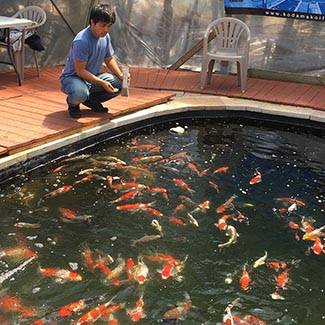 It is devastating to see your koi / carp friends sick, and trying to find quick answers or pictures of sick koi can become overwhelming. Use our quick reference koi health checklist, table of symptoms, and table of diseases to diagnose your koi’s diseases better.
It is devastating to see your koi / carp friends sick, and trying to find quick answers or pictures of sick koi can become overwhelming. Use our quick reference koi health checklist, table of symptoms, and table of diseases to diagnose your koi’s diseases better.
How to Know if My Koi Fish is Sick?
Changes in behavior, such as erratic swimming, koi swimming upside down, abnormal feeding patterns or isolating themselves from others can indicate that your koi fish is sick.
Physical symptoms like red gills, cloudy or popped eyes, and swollen abdomen are used to correctly diagnose koi fish diseases.
We have created this article and checklist guide to help you easily sort through the many koi diseases and their symptoms to answer the unfortunate question of “why are my koi fish dying?”
Simple Steps to Diagnose Common Koi Illnesses and Carp Diseases
TABLE OF CONTENTS
Below this checklist download, you will find more information on how to manage sick koi fish in your pond as well as a table of diseases and symptoms you can search to learn more. Start by downloading our FREE Koi Health Checklist.
- Koi Health Checklist (Infographic)
- Understanding Your Koi’s Behavior
- 5 Areas to Analyze for Koi Diseases
- Koi Disease Pictures
- Quick Questions to Help Diagnose Koi Diseases, Koi Illnesses & Other Issues
- How to Save Koi Fish From Dying
- Swim Bladder Disease
- Koi Preventative Measures
- 12 Common Koi Diseases and Symptoms
- Koi Diseases by Symptoms Table
- Symptoms, Treatment & Control of Fish Disease Table
We’ll Email You Our Farm’s Koi Health Checklist
Download and print this one page document to easily reference for a quick diagnosis! To help you with your Koi symptom diagnosis, we created this koi health checklist. For access to the checklist, sign up below and we will happily send you the highest quality file for using with your pond.
Enter email to join our newsletter and receive koi health checklist.
Read on for help diagnosing koi health issues…
While it is an unfortunate topic, it is incredibly important that koi fish owners learn to quickly diagnose the symptoms of a koi health issue to be able to provide support and save other koi from dying.
We have compiled generations of research from the farm into an extensive, yet simple, guide to catch koi sickness as soon as possible and diagnose correctly. Not only will your koi be happy and healthy, you will save precious time and money by ascertaining which treatments will most likely be effective.
Keep this guide and refer back often, so when illness does happen, you can act swiftly and confidently!
By becoming familiar with koi behaviors and a little careful observation, you will be able to catch illnesses early as well as provide excellent preventative care. We hope this guide provides comfort and guidance on how to treat koi that are sick to keep them in your family as long as possible!
VIDEO: How to Treat Sick Koi and Diagnose Symptoms for Koi Fish Illness
Discover the Ultimate Koi Treatment Kit for Your Koi’s Health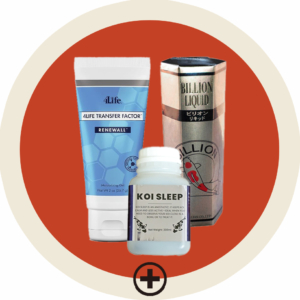
Designed to keep your pond pristine and your fish thriving, our comprehensive kit tackles common ailments and promotes overall well-being. Easy to use and highly effective, it’s the perfect choice for both seasoned Koi keepers and beginners.
Treatment Kit Includes:
- Koi Sleep
- Billion Liquid
- 4Life Gelcream
Ensure your Koi stays vibrant and healthy by purchasing our trusted solution. Buy Now!
Understanding Your Koi’s Behavior
The simplest way to catch signs of disease or stress early is to become familiar with your koi’s behaviors. Sick koi will exhibit common patterns and are easy to spot!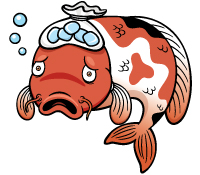
Observe behavior both when they are alone and when you feed them.
You will want to first observe their behavior without them noticing you. Koi will get to know you by sight and may make movements towards you if they see you. Since they become used to you approaching to feed them, even a sluggish koi will move quickly if it is anticipating food! Keeping an eye on them from a distance will help you spot anybody that is having a tough time.
Do you see any koi congregating by the water flow or surfacing sporadically? Note any fish that isolate themselves or seem sluggish. Seeing several koi swimming erratically, rubbing themselves along the wall or flashing (jumping out of the water) can indicate parasites have spread.
Next, observe your koi when it’s feeding time, paying careful attention to new koi as they are mingling. Are there any that are not eating, or seem disinterested in feeding? Loss of appetite or erratic feeding is present in almost all cases of stress and illness, and is a sure sign that you should investigate further.
At the end of this article is an in-depth table that will help you decide on if koi / carp has a symptom of diseases. Refer to this symptoms and diseases table once you have observed any sick koi.
5 Areas to Analyze for Koi Diseases
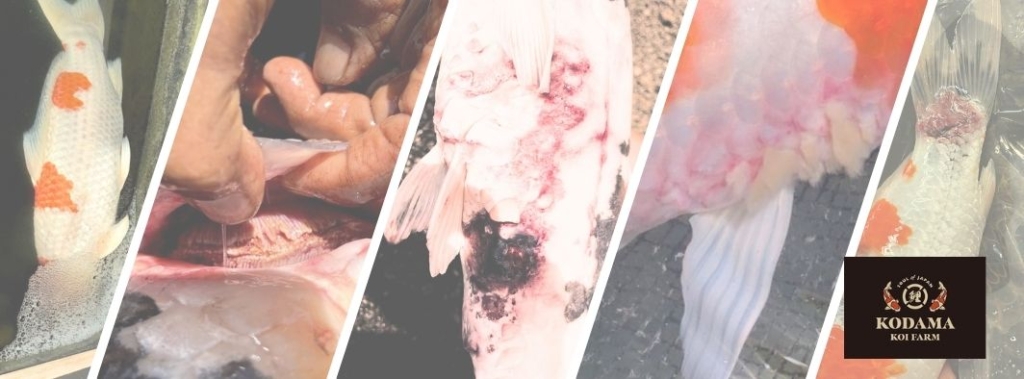
These five areas are simple, yet will give you plenty of information on your koi or carp.
Make notes and then use the koi health checklist we emailed you and table below to narrow down what’s wrong. Act quickly, but do not jump to conclusions. Overlapping symptoms may seem overwhelming, but with a little patience and these tools at your disposal you will be able to correctly pinpoint the problem.
1. Koi Fish Feces/Waste
If you see floating or gelatinous feces, this means the koi has indigestion from a scrape in the 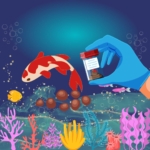 intestinal lining. Normal koi feces should sink and dissolve in the water right away. Consider what your koi might be eating. Not only the quality of koi specific food, but additional human food snacks they’ve had, and if there is any harmful debris in the pond they may have ingested.
intestinal lining. Normal koi feces should sink and dissolve in the water right away. Consider what your koi might be eating. Not only the quality of koi specific food, but additional human food snacks they’ve had, and if there is any harmful debris in the pond they may have ingested.
2. Pond Water Quality
Water quality is the single most important factor in your koi’s health.
If you need a refresher, here are some tips for improving the nitrogen cycle in your pond. 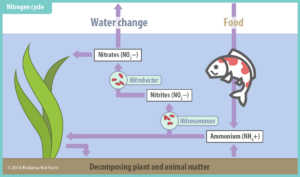
When your koi seem stressed without an obvious reason, testing the water is the first place to start. Brown or cloudy water of high turbidity is always unhealthy, but even water that appears fairly clear to the naked eye may not be in the healthy range.
You must be regularly testing your koi pond water, with immediate tests if you observe sick or stressed koi. There should be as close to zero ammonia/nitrates in your pond as possible, as imbalances can escalate quickly and have devastating effects.
3. Koi Physical Body Examination
If you have observed any unusual behavior patterns, you will need to physically examine the suspected koi.
You can diagnose a lot with the naked eye but if you have access to or invest in a small microscope, you 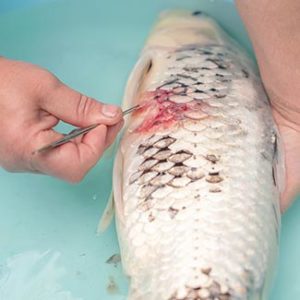 will be able to look at the scales and get a much clearer picture. Don’t feel daunted by the idea of a microscope! A simple inexpensive one will work great, and they are incredibly helpful, quick, and accurate for diagnoses.
will be able to look at the scales and get a much clearer picture. Don’t feel daunted by the idea of a microscope! A simple inexpensive one will work great, and they are incredibly helpful, quick, and accurate for diagnoses.
Externally, check if there is any opaque mucus on the body, or wormhole like appearance on scales. Do you see small parasites with the naked eye? If you do, the microscope will help you differentiate if they are rod shaped (anchor worm) or disk shaped (argulosis, argulus infestation or fish louse).
Next, run your hands along the body. If it has lost its natural slipperiness and become dry or sandpapery this could indicate chilodonella, gyrodactylus or dactylogyrus.
Unhealthy koi may have scales that have risen up from the body, like a pinecone that has released its seeds. Look for red congestion on the skin, gills or mouth and make note if there is any bleeding.
4. Changes in Koi Appearance
Koi Fish Eyes
Koi eyes can give you many clues about their illness.

Are they popping out, or sunken in? Are they infected or even beginning to rot? If you see any koi with abnormalities in their eyes, refer to the table below for specific diseases.
Koi Abdomen
The abdomen may become swollen due to bloating. Also look for damage or redness around
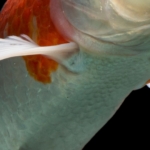
the gills or mouth. A koi who cannot breathe properly will deteriorate fast, so catching issues around the gills and mouth early is one of the best ways to save a koi fish from dying.
Koi Gills
Infected gills will often have white secretion or abnormal amounts
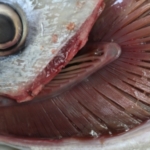
of mucus, which can also begrey or yellowish in color. You may notice the base of the gills are white, or see white when they are open for respiration. Healthy gills have a deep pink color. Additionally, if the gill covers remain open (instead of opening and closing during respiration) this is a sign of parasites.
5. Koi Fish Death Patterns
In the heartbreaking event of koi death, understanding the patterns can save the others, and prevent more tragedies in the future.
If you have a mass die-off, you most likely have a hypoxic (oxygen deficient) pond.
We cannot stress enough how important healthy water is for koi.
High Density Bacterial or Parasite Infection
Did you recently introduce new koi without doing a proper quarantine? This is a very likely cause, as sick koi can spread its illness to the others very swiftly due to the fluid shared environment.
Poisonous Substance
There is also the possibility that a poisonous substance got into the water, quickly killing all koi. Is there any construction or renovation happening nearby? Heavy rains will carry chemicals from far away and affect your koi’s well being. Your koi pond is a delicate ecosystem that needs protection from unwanted elements.
Adding Water
A very common mistake is that pond owners add ‘fresh water’ during a water change, forgetting that the chlorine in our public water supply can kill koi overnight. It unfortunately happens more than you might think, so be sure the water you add has been tested or distilled.
Other Clues in Patterns of Koi Death
Oxygen deficiency may be the cause if you see the larger, fatter koi die first.
If a few koi are dying everyday, even if no abnormalities were observed the day before, this may be caused by koi herpes virus or columnaris, another bacterial infection.
If you see koi swimming lethargically or erratically around drain pipes or waterfalls and then dying, suspect that it was a parasite such as dactylogyrus or gyrodactylus.
Gallery: Koi Disease Pictures
-
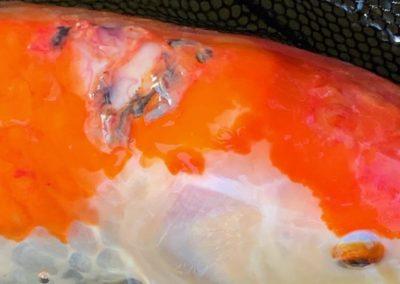
Infection from Net Scratch
-
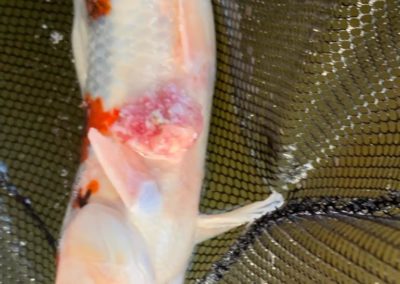
Koi Infection from Belly Scratch
-
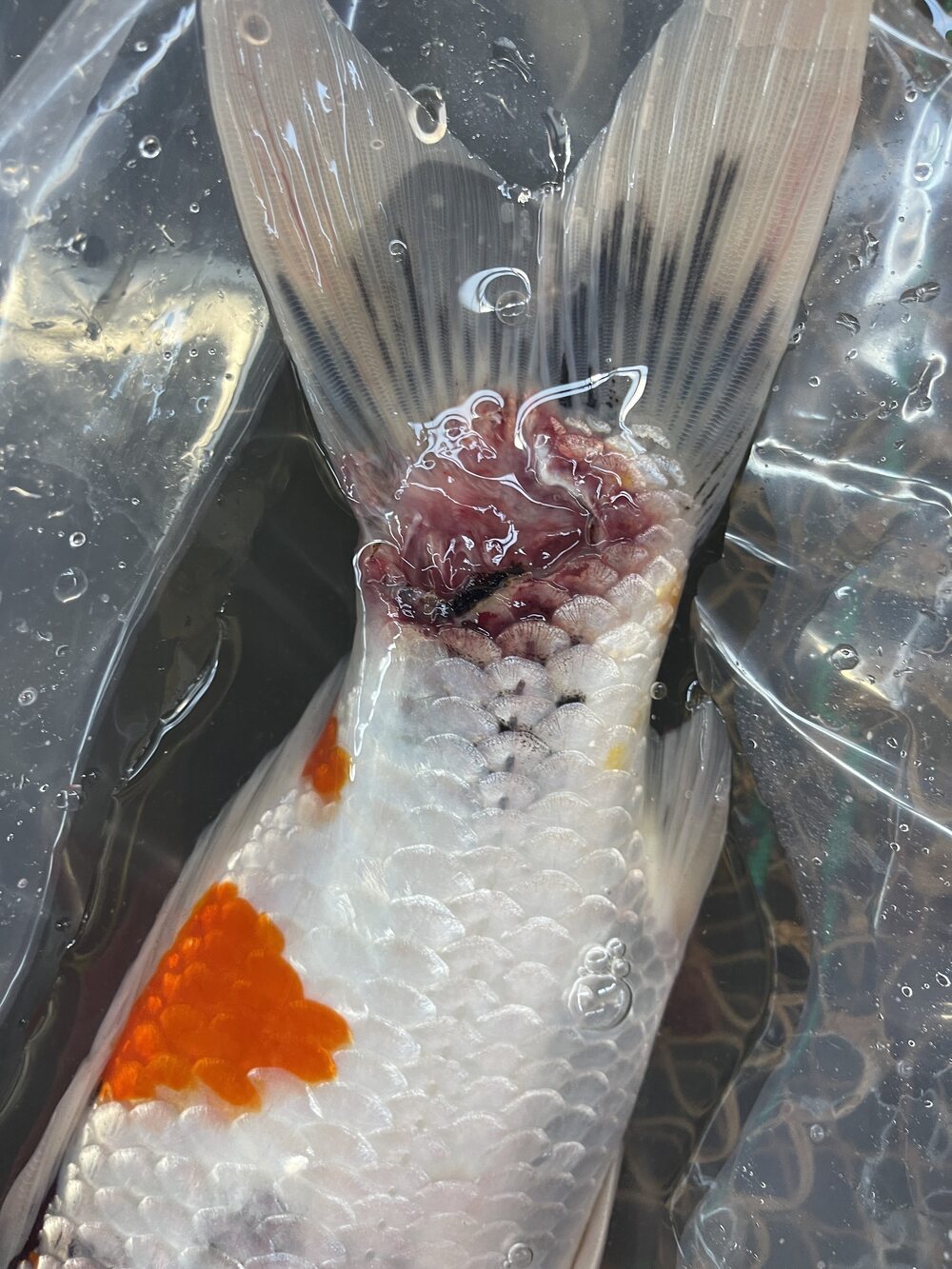
Koi Fish Ulcer
-

Koi Fungus
-
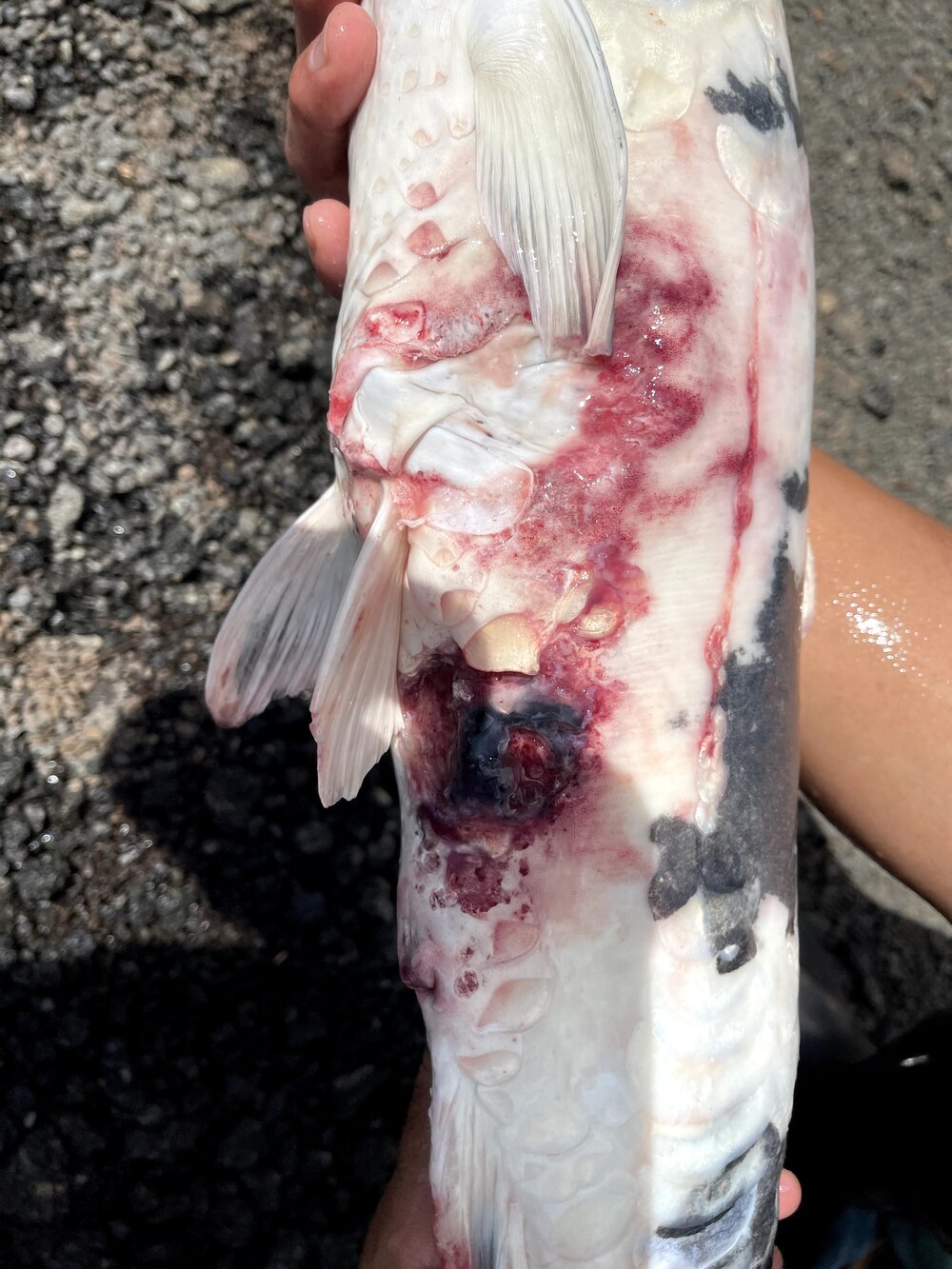
Belly Scratch Infection
-
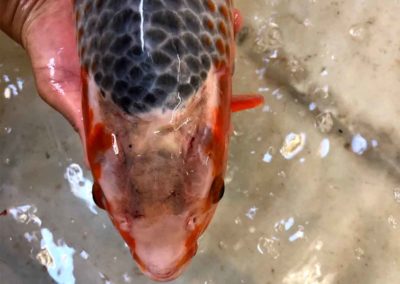
Questions to Diagnose Koi Diseases
Taro Kodama uses these questions to figure out what is wrong with koi fish health. Make sure you ask yourself these questions to quickly determine what to do next in your investigations. Make sure you take your time to figure out the hypothesis of your issue and act quickly. Make sure you contact a professional whenever possible.
- Diagnosis Questions
IMPORTANT: How to Save your Koi Fish from Dying
Once you have detected an illness, act quickly to restore health and stop the spread to other koi.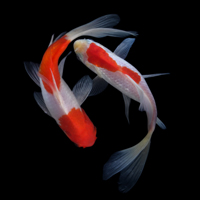
Parasites can be physically removed. Along with parasite medication, you can help your koi regain wellness and feel more comfortable by removing any visible parasites gently with tweezers.
Both bacterial infections and parasites can be treated medically:
- Bath Treatment Types: If you are sure your pond water is healthy and only see a single or several koi exhibiting signs of sickness, you can quarantine koi fish for treatment. This bath type treatment is both effective and cost efficient, as the volume of water that needs to be treated will be greatly reduced.
- Feed Additive Options: Here is a guide to making medicated koi food at home for bacteria infections, but unfortunately there is no feeding treatment for parasites.
- If it is Pinecone Disease: You can alleviate pressure by gently draining abscess before bath treatments. Please be extremely careful and don’t work outside of your expertise and comfort with you koi.
One of the best ways to save a koi fish from dying is to catch issues around the gills and mouth early!
Spotlight: Swim Bladder Disease
Swim bladder disease, or swim bladder disorder, is characterized by a fish’s inability to regulate its buoyancy. The most obvious symptom is a fish who is unable to swim without great effort, and sits either at the top or bottom of the pond. SBD is the common name for two types of buoyancy disorders, each having its own possible causes and treatments. It often times leads to death if the fish is not taken care of properly.
Positive Buoyancy Disorder
My koi fish is floating on side, but is alive. What do I do?
If your koi floats at the top of the pond or rolled on its side (but not dead), then they have an excess of internal gas, usually from an over inflated swim bladder. This excess air means they are unable to completely submerge. Their skin will become damaged, leading to deadly infections if not treated properlykm. Positive buoyancy disorder also affects your fish’s ability to feed. Even though the food floats, they are unable to position themselves well to grasp it.
There are several possible causes for positive buoyancy disorder. If you are lucky, it could be gastrointestinal in nature. A change in diet, or a couple days of not feeding (as long as the koi is healthy and has been eating normally up to this point) could work out excess gas. It might also be parasites, a physical shift in the swim bladder, or other unknown reasons that hyperinflate the swim bladder. All of those need to be diagnosed properly and treated by a specialized vet. Treatments could include surgically removing tumors that have displaced the swim bladder, removing air directly from the bladder with a syringe, or other treatments deemed by diagnoses.
What you can do is to keep your fish comfortable by hand feeding them, and keeping their exposed skin moist. There are also humectants that can help the skin, but make sure you use one that is safe for koi fish.
Negative Buoyancy Disorder
Negative buoyancy disorders are more fatal due in no small part to the fact that they usually go undiagnosed longer. A fish floating to the top is very obvious, while a koi who stays at the bottom can go unnoticed. First and foremost, being familiar with your fish personally is the best defense. Koi can live over 50 years, and are part of your family. Enjoying a few moments with them daily is excellent for your tranquility and peace, as well allowing you to notice if they are behaving differently.
A fish that struggles to surface, or can’t get close at all, will need help eating. You can help comfort and nurse your scared koi by gently reaching down into the pond and hand feeding. Make sure to give it time, as it is harder to position and get food, and they won’t be able to easily get extras that might float away or sink. If you do not make sure you koi eats, they will quickly become emaciated and die, which is not something you wish upon them.
The other biggest concern is that they get ulcers, or the equivalent of bed sores (like humans that are laid up for long periods). You can help them in several ways. One, make sure your bottom is lined with very smooth substrates, such as glass rocks. Secondly, you can use a sling with a float or other method to help the fish stay higher up. Be aware though that these slings and substrates may still cause rubbing and ulcers, so keep an eye on your poor fish, and maybe treat with cream as needed. Also, switch up your technique to rotate where the pressure will be, the same way a bedridden person has help changing positions every so often.
Diagnosis and treatment will require a vet, as there could be anything from an infection to a rupture causing the buildup of fluid. All of these show the same symptom of being grounded, yet must be treated specifically and guessing can cause much more harm.
How do I Know if Koi are Healthy?
As you become familiar with your koi’s day to day behavior, abnormal actions become easy to spot!
Look for any koi fish floating on their side, that have separated from the group, or are floating sluggishly by the waterfall, return pipe, or drain. Self isolation points to a possible bacterial infection as does the odd floating.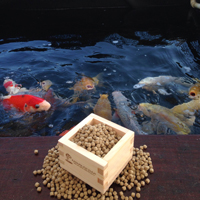
If you see several koi swimming erratically, rubbing themselves along the bottom or wall, or jumping out of the water (flashing), this is often caused by parasites.
Next, pay attention when it’s feeding time. Pay careful attention to new koi and any that are not eating, or seem disinterested in feeding. Loss of appetite or erratic feeding is present in almost all cases of stress and illness, and is a sure sign that you should investigate further.
Use our checklist to diagnose their patterns and see if they are acting normal. We have a list of symptoms, diseases, and treatments at the end of this article.
Preventative Measures to Avoid Koi Fish Diseases & Achieve Better Koi Health
Koi have long lifespans, using preventative care will be the best way to keep your friends healthy for a long time.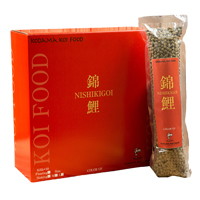
Feed Options – Do not discount the importance of the best quality koi food. As with anything, you get what you pay for. Like humans with fast food, you may not notice in the short term, but it catches in the form of sluggishness and increased susceptibility to sickness. The long term health of your koi will be greatly enhanced by always feeding them quality food.
Water – This is the single most important factor in keeping koi safe from illness and stress-free! They live in and breathe the pond water; unbalanced water will have swift devastating effects for you koi. Understanding and following these tips for improving nitrogen cycle and using a biological koi pond filter will give you the know-how needed to maintain a beneficial environment. Always check water quality by eye for noticable changes and regularly use test kits to catch unseen problems.
On top of keeping ammonia and nitrites as close to zero as possible, healthy water is oxygenated water. Running water/waterfalls can help a large pond stay aerated, but may not be enough. It is best to prepare an extra air pump to make certain there is enough aeration. Your koi need plenty of fresh oxygen to breathe!
Plants can filter and oxygenate your pond, and they add beauty to your environment and experience, but require careful strategizing on your placement! Hungry koi will most likely nibble on plant roots. The plants will die and the debris will then dirty the pond. Proper PROFESSIONAL plant selection and set up are necessary. If you decide to utilize plants, they need to be placed where koi cannot eat them. If you are in doubt, DON’T put ANY plants in your pond, for the safety of you koi.
Always check after feeding to see if there is leftover food falling to the bottom. Overfeeding can lead to high ammonia in the water as the excess begins to rot. A good rule of thumb is only feed them as much as they vigorously eat in a minute’s time. Feed them like this twice a day. READ MORE ABOUT KOI FEEDING.
Quarantine any new or suspected sick koi – All of your care can be thrown off balance if a sick koi is introduced into the pond. Follow this koi quarantining tank process when introducing new koi into your pond. We recommend quarantining even if you highly trust your koi source. A little extra precaution can prevent a tragedy.
Learn more about using medicated koi food on our blog!

12 Common Koi Diseases and Treatments
Here is a quick view of the 12 most common koi fish diseases. Below are tables with more in-depth diagnosis tips, along with a searchable table with 54 known koi fish diseases to help you hone in on what is bothering your fish.
- Anchor Worm – A rod shaped parasite which can usually be seen with the naked. Use a microscope for easy diagnoses. Look for areas that are red and infected looking to see if they are the cause.
- Chilodonellosis – Infection around the gills leads to problems breathing. Koi may gather by water inlet to try and get more oxygen. Appetite/weight loss are often observed.
- Costiosis (Ichthyobodosis) – White cloud-like mucus and erosion on body surface. Once it spreads to the gills you fish won’t be able to breathe and can die. Loss of weight/appetite also symptoms, as is congregating near aeration or water inlet to try and breathe.
- Fish Lice (Argulosis) – Can display violent and erratic swimming. Your koi fish will often scrape itself along the side or bottom of the pond to try and remove lice. Wiggling of pectoral and dorsal fins also a good indicator.
- Fluke (Dactylogyrosis) – The gills are mainly parasitized which causes white excess mucus excretion. The fish becomes anorexic, not eating and quickly losing weight. They will have trouble breathing also due to the parasites so may float close to the surface or near aeration.
- Gill Rot (Columnaris) – White and yellow substances cover the body. Scales and mucus coming off make the fish appear as if it’s covered in white rags. Can kill your fish due to emaciation.
- Hole Disease – Ulcer that is found typically on the abdomen, dorsal or tail section. Muscle is exposed as if a hole has been carved out. Highly contagious!
- New Hole Disease – Antibacterial medications do not work. Scales will drop out and hemorrhage. Despite the absence of infection this disease progresses swiftly, so it is important to diagnose correctly between New Hole and Hole disease. More in-depth information in the tables below will help.
- Pine cone disease – Scales raise up from the skin, and heavily affected fish look like a pine cone that has released seeds.
- Swim Bladder Disease – A koi that rests on the bottom of the pond and thrashes erratically when it tries to surface can indicate SBD. Look on the belly to see if ulcers are forming from rubbing on the bottom. We do not include this in the table below. This is considered a non-treatable condition, although there are anecdotes of koi overcoming it.
- Trichodinosis (Cyclochita) – Infected surface becomes thicker looking due to mucus buildup. Breathing problems are eminent. Be EXTRA careful around fry as this can quickly kill them.
- White Spot Disease – Tiny white spots, first observed on the head or pectoral fins, which will spread all over the body. Koi will often scrape the affected areas along the bottom or pond walls. Over time it will become lethargic.
Koi Diseases by Symptoms Table
Sort through all 54 diseases that could be harming your koi. Use the search feature to look for keywords, change the amount of results that are being shown, and use pagination to select a different page.
| Disease | Symptoms | Cause | |
|---|---|---|---|
| Ich (White Spot Disease) | White spots on skin and gills, flashing, lethargy | Ichthyophthirius multifiliis (protozoan parasite) | |
| Costia | Excess mucus, respiratory distress, sunken eyes | Ichthyobodo necator (protozoan parasite) | |
| Trichodina | Scratching, flashing, lethargy | Trichodina spp. (protozoan parasite) | |
| Chilodonella | Gray patches on body, clamped fins, gasping | Chilodonella spp. (protozoan parasite) | |
| Flukes (Gill & Skin) | Gasping at surface, clamped fins, excess mucus | Dactylogyrus (gill fluke), Gyrodactylus (skin fluke) | |
| Anchor Worm | Worm-like protrusions, red sores, rubbing | Lernaea spp. (crustacean parasite) | |
| Fish Lice | Visible parasites, erratic swimming, scratching | Argulus spp. (crustacean parasite) | |
| Velvet Disease | Fine yellowish dust on skin, lethargy | Piscinoodinium spp. (dinoflagellate parasite) | |
| Columnaris | Cotton-like patches, fin erosion, ulcers | Flavobacterium columnare (bacteria) | |
| Fin Rot | Frayed fins, reddened fin bases | Bacterial infection, often Aeromonas spp. | |
| Mouth Rot | Erosion of mouth tissue, difficulty eating | Bacterial infection | |
| Ulcers | Open sores on body, reddened areas | Bacterial infection, often Aeromonas spp. | |
| Dropsy | Swollen body, raised scales, lethargy | Internal bacterial infection, organ failure | |
| Swim Bladder Disease | Difficulty maintaining buoyancy, floating or sinking | Physical injury, infection, or constipation | |
| Koi Herpesvirus (KHV) | Gill necrosis, sunken eyes, lethargy | Cyprinid herpesvirus 3 | |
| Spring Viremia of Carp | Hemorrhages, pale gills, abdominal swelling | Rhabdovirus carpio | |
| Carp Pox | Waxy, white lesions on skin and fins | Herpesvirus | |
| Lymphocystis | Cauliflower-like growths on fins and body | Iridovirus | |
| Saprolegniasis (Fungal Infection) | Cotton-like growths on skin and gills | Saprolegnia spp. (fungus) | |
| Gill Hyperplasia | Thickened gill tissue, labored breathing | Chronic irritation, poor water quality | |
| Eye Cloudiness | Hazy or opaque eyes | Bacterial infection, poor water quality | |
| Red Streaks in Fins | Blood-red lines in fins | Bacterial septicemia | |
| Bacterial Gill Disease | Inflamed gills, gasping at surface | Bacterial infection | |
| Skin Flukes | Scratching, excess mucus, skin irritation | Gyrodactylus spp. (monogenean parasite) | |
| Gill Flukes | Gasping, clamped fins, reduced appetite | Dactylogyrus spp. (monogenean parasite) | |
| White Spot on Mouth | White spots or patches around mouth | Ichthyophthirius multifiliis or fungal infection | |
| Velvet on Mouth | Yellowish film on mouth area | Piscinoodinium spp. | |
| Cotton Mouth | White, cotton-like growth around mouth | Flavobacterium columnare | |
| Gill Necrosis | Decaying gill tissue, respiratory distress | Viral or bacterial infection | |
| Hemorrhagic Septicemia | Red patches on body, bleeding fins | Viral or bacterial infection | |
| Eye Pop (Exophthalmia) | Bulging eyes | Internal infection, poor water quality | |
| Pinecone Disease | Raised scales resembling a pinecone | Internal infection, often associated with dropsy | |
| Clamped Fins | Fins held close to body | Stress, poor water quality, parasitic infection | |
| Lethargy | Reduced activity, slow movement | Various diseases, poor water quality | |
| Flashing | Rubbing body against objects | Parasitic infection, skin irritation | |
| Loss of Appetite | Refusal to eat | Stress, illness, poor water quality | |
| Breathing at Surface | Gasping for air at water surface | Low oxygen levels, gill disease | |
| Sitting at Bottom | Resting at pond bottom, inactivity | Illness, stress, poor water conditions | |
| Hanging Near Waterfall | Staying near moving water | Seeking higher oxygen levels due to distress | |
| Rapid Gill Movement | Fast breathing, gill flaring | Respiratory distress, gill parasites | |
| Excess Mucus Production | Slimy coating on skin | Parasitic infection, irritation | |
| Skin Discoloration | Unusual pigmentation, dark or pale areas | Stress, disease, poor water quality | |
| Scale Loss | Missing scales, rough skin | Physical injury, infection | |
| Fin Erosion | Gradual wearing away of fins | Bacterial or fungal infection | |
| Tail Rot | Decay of tail fin | Bacterial infection | |
| Mouth Fungus | White, cotton-like growth in mouth | Fungal infection | |
| Body Slime | Excessive slime on body surface | Parasitic infection, poor water quality | |
| Gill Mottling | Patchy coloration on gills | Viral infection (e.g., KHV) | |
| Sunken Eyes | Eyes appear recessed | Severe illness, dehydration | |
| Blisters on Skin | Fluid-filled bumps | Viral infection, irritation | |
| Abdominal Swelling | Enlarged belly | Internal infection, organ failure | |
| Skin Hemorrhages | Red spots or streaks on skin | Bacterial septicemia | |
| Loss of Balance | Difficulty swimming upright | Swim bladder disorder, neurological issues | |
| Isolation from Group | Staying away from other fish | Illness, stress |
Cloudy Eye (White, Cloudy Surface on the Eye)
Cloudy eye in koi fish can be a symptom of a disease, but it’s not a disease in itself
This is often caused by:
-
A small injury during shipping
-
A mild bacterial infection
-
A change in water quality (pH, ammonia, etc.)
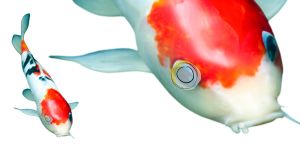
What we recommend (if the Koi is still active and eating):
1. Keep the Koi in a separate clean tank
2. Check and keep good water quality
3. Try a salt bath (0.5%)
4. If no improvement in 1 week or if it gets worse
The Symptoms, Treatment & Control of Koi Fish Disease Table
We’ve outlined 12 common diseases and included their symptoms, season, and tips for treatment. Use this table with the koi health checklist and the Koi Diseases by Symptoms Table to identify the source of the health problem of your koi.
On mobile, scroll to the right to see koi treatment and control options.
Original Source: ZNA (Zen Nippon Airinkai) Magazine. Translated with permission by Kodama Koi Farm
Good Luck in Your Koi Diseases Diagnosis & Support
Koi are exquisite animals and we have devoted our lives to these charming creatures. We hope you will share our expertise with koi admirers around the world and post your own comments below.
Please check back and use this guide often to enjoy a long life with your “living jewels”. If you want to keep learning more, here are some of our favorite parts of the website. To health and success!
Relevant Koi Content
- Learn our koi quarantining tank process
- Tips for improving pond nitrogen cycle
- The biological koi pond filter we use at the farm
- How to make medicated koi food at home
- Koi For Sale
Disclaimers
1. *It is recommended that injections be performed under a vet’s guidance and/or supervision.
2. **Kodama Koi Farm &/OR Kodama Koi Garden is not responsible for loss of fish, damage to pond equipment, or other liabilities or damages incurred directly or indirectly from the use of the information contained in this guide (the “Koi Health Diagnostics Chart/Manual”).
3. ***Customer is responsible for performing any treatments or administering any medications indicated in this guide. Recommendations and instructions are made based on generally accepted circumstances & methods and may not apply to special or exclusive circumstances. Customer is ultimately responsible for observing & determining the situation and choosing the most applicable course of action.
4. ****Read all information, instructions and warnings carefully before using and administering any medications, especially injections. Those using this guide must also read all instructions and warnings provided by the manufacturer of, or printed on the particular medication/product label that he/she is using prior to using the medication/product. Customer is responsible for taking any precautions and understanding all warnings provided by different medications and products mentioned in this guide, or otherwise.



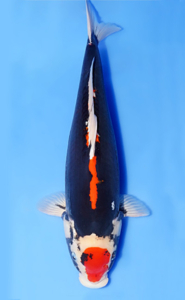
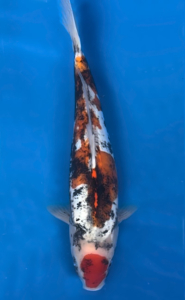
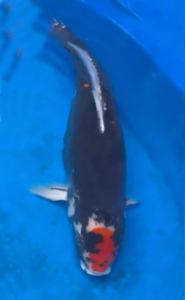



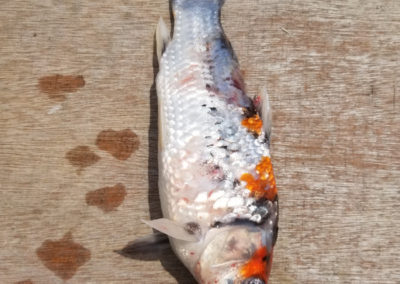


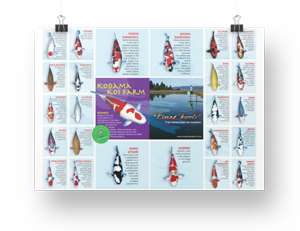

i have a 7 pound coy that suffered water deprivation when a sump pump when haywire.. he simi recovered, but listed to the side .. i kept moving him..he would recover and slowly swim away..that was 4 days ago..this a.m. i found him in my filter basket..his gills r still moving slowly,but he is absolutely motionless…he also has several growths on his body…is he paralized or next to dead ?
I’m am replying to all of u I suggest while u wait for a reply go to The disease symptoms diagnosis and treatment section on this site it is very detailed and specific on each disease symptoms Diagnosis and treatment so just go read read and read some more start at step one Recognizing koi behavior is the first and most important step for Diagnosis I feel I could accurately answer all these questions from the studying I’ve done but it’s not my place so go study and be a good koi owner good luck
One of my coy’s is listed to one side and slow moving, is there any treatment i could use? Many thanks Hans Timm
I have two Koi fish in the same pond. One is very healthy and the other is sick. The sick one has a big stomach and cannot surface. Any ideas?
I have a koi that is heavely swollen – abnormally.
Is there something specific that cause this & is it cureable
.?every spring I have at least one fish that becomes blotted and dies, what is causing this
I have a koi 3 lbs which came from another pond with two other’s in my pond with ten health koi all sizes All have been fine for three weeks but this one has started floating around like its dead for two days then when touch it comes back to life then act dead again any help on what going on with in ? Please
Good day,how to treat koi with belly drop or big belly koi..its my 1st koi that i bought for cheap price,not really a good quality koi but we love that koi and im hoping to find some answers if possible to treat..
What causes Koi to have a crook or bend in their tail at the junction of the body?
I have a ghost koi that seems to have a bent spine! It can’t swim properly and when resting it lays on its side at the bottom ! Any suggestions?
I need help diagnosing my Koi fish. It has a some kind of grows on the forehead almost looking like blisters. I took photos of it can I submit them to you. The forehead of the fish is red but the growth is light orange in color. It also has some round black spots on its body. It does not behave sick and is eating and at least 5 years old. No other fish is infected so far. I would be very grateful for your help and are looking forward to your reply.
Hi, i have a koi that has a white jelly like worm comming from what i call nostrils, i have given it salt baths but it dose not seem to work. I would like an poppinion on this
my big koi come to the top of the water and look like they are gulping oxygen with their mouths the big ones have been dying off i keep declorinatoring chemicals in the water everytime i fill thier tyank the tank is about 3000 gallons do i have a problem i havent considered?
They need oxygen! Add a bubbler or fountain
i also have a large waterfall in the koi pond
Our Koi fish is hanging out on top of water acts like it is hard for it to go deeper.
My koi has cloudy substance on nostrils and bulging eye, what causes it and how to treat it. Thanks
My koi has white jelly like substance at it’s nostrils and bulging eyes. How do I treat it?. Thanks
Sorry it is probably too late to respond, but
It is hard to say without seeing the Koi or pictures, but probably, you do not have to worry about the jelly like substance. But the bulging eyes may be a problem.
By putting pea gravel in the bottom of a 120 gal tank. I see my 8 inch koi pick up the gravel and spit it out. Now i have a fish with a mouth that looks like he red lipstick , Looks like he is bleeding.Like he bruise himself. Do you think i should take out the gravel?Thanks Tony Rosa
I am not sure if it has anything to do with gravel, but yes, you should take care of him. It can be a beginning of mouth rot.
My koi seem to rub against the bottom drain mostly at night , I’m not sure what to treat. Other than that the koi seem to be active and look healthy. Any suggestions would be great. Thanks
If they do constantly, there is a chance of parasites. Since spring is just around the corner, you may want to treat the whole pond anyway. https://www.kodamakoigarden.com/preparing-koi-pond-for-spring/#treat-your-koi-pond
This information should help you.
My koi seem to have developed cloudy eyes. I am going to change the water. hat else can I do, please?
Sorry for the late reply. Did water change help? Without seeing the Koi in person, it is hard to answer. But if it were my Koi, I would try to add salt and make it 0.5% and see .
New koi keeps laying on bottom of pond , then swims off , eating ok , swimming ok ,but just lays for 20 mins or more. Water quality tested by supplier.been 10 days now.
Is a Koi big? Did the Koi travel long way to get to your pond? if so, Koi may be just exhausted. I have see a large Koi like that. It took the Koi a few months to start swimming normally. Or The Koi may have some internal issues. Again, I am only guessing.
Good afternoon.
I request your advice regarding a Koi that is 16 years old and has a length of more than 70 cm.
The same presented a white spot with a kind of filament similar to a break or a blow for a long time.
Some time later the fish changed its behavior and began to perch completely on the bottom of the pond. Nothing normal, but after several laps he sits down and stays calm.
Sometimes it presents sudden movements, such as spasms and it swims out, it also bristles its fins and tail, sometimes rubs itself with the floor of the pond, blinks frequently and yawns.
After that white spot, more spots began to appear in the area of his body, the spots have the appearance of discolored scales, they are not points.
We decided to give METRONIDAZOLE in the food for 7 days and we saw an improvement, but the stains have spread to other areas.
We have also seen some long, stringy feces in the pond, but we cannot determine which Koi they belong to as we have 2.
For a few days he has spent more time perched on the bottom and it takes a lot for him to eat, he goes around a lot, eats small amounts and he swims away and after a while he comes back.
The spots have not spread, but their behavior is completely abnormal.
I greatly appreciate your help.
This seems to be a little complicated issue. I suggest you contact a local vet who can see your Koi and pond in person and get advice. I am sorry I can not be much help here….
Hi , I treated my whole pond for parisites as my koi were flashing and jumping , treated with salt , they seem to do it more ,, salt 0.28% ,should I increase treatment of salt or try something else , water temp 13 degrees ( winter)
Sorry this may be a late reply, but lately most of parasites are resistant to parasites. I would suggest you use parasite medicines like Koi prazi, proform C, Terminate
I found my oldest 18 year old Golden koi (Buddha) dead this am
She had a hole in her stomach like it exploded and a big sack of her eggs were pushing out. I’ve been reading so much I’m just wanting to know an experts answer here. Tumor, egg, bloating issues, or something else? Water quality is really good, I use dechlorinator whenever I add water and only feed them 1-2 times a day very good food. So sad 😞 we loved her and al her mates are sad and startled today too
I also sent you an email, but I am sorry I do not have the information on this. I would suggest you talk to a vet.
Hi have had a large white Koi die. Other koi are fine. When examining it seemed under the scales each side it looked like blood. When touching the side it seemed to move. Rescue me please
Hi I have a ten year old koi who got 2 pink spots on her back I thought it was an anchor worm so took it out to remove it but noticed a bruise type lump under the right bottom fin , a few more pink spots on the skates and it is bleeding from the gills ? Can you help . Water quality is good and fish is feeding normally ? Thanks Janice . I lost a similar fish last month after it appeared to get pink thready veins throughout its body fins and tail. Treated it with anti bacterial and salt baths and it perked up but then sadly died. I can’t lose this one too ! Please help .
Hi Janice. If you still need assistance please email us at info@kodamakoifarm.com
Have a Koi that appears to not be able to close its mouth and when tries to feed on pellets he can’t suck any in? It’s been about a week, he is still somewhat active but we are concerned
for quicker response please send us videos or photos of the koi behavior. our email is info@kodamakoifarm.com
My Koi tries to eat, but is unable to swallow. The fish is 16 years old and 12 inches I would appreciate any advice.
for quicker response on personal koi sickness please send us photos or videos at info@kodamakoifarm.com
I have about 10 koi that are about 8 years old. My pond used to become somewhat cloudy each late spring, but that did not affect my koi. This summer, the pond water suddenly became crystal clear and shortly thereafter, my koi lost their appetite. I have been feeding them premium koi food, but for the last 2 months their appetites waned and in the past couple of weeks they have completely ceased eating the koi food. I added some pond salt to no avail. Can you help me?
KOI 22 yrs in 29 gallon tank. fist stopped eating food a few days ago and spent most time still on the bottom in corner. I increased salt level and started Melafix & Pimafix. Tested water for pH, Nitrates, Ammonia –all OK. Seemed stable but suddenly floating on his side curved middle of tank
I keep losing my fish they start swimming really slow kinda swim towards the top and then swim on their side then completely roll over but if you touch it it starts swimming again
Hi there we have small koi that are growing but have noticed one of them has black lips please help thanks
My butterfly koi is sitting in the roots of the plants and lays vertical in the water. It will swim around but goes back to same spot time and time again and stays there most of the day. No visible marks or discolouring.
Good morning Sir. my koi have red spot swelling on the body. what should i do, please advise
I have heard of some koi breeders in Japan mentioning. Koi having a cold. They show some slime coat thickening whitish. Could you explain that some.
My koi developed a pea size pink growth on its scales on its side closer to its gill. Is this papilloma. How do I treat it? Is it deadly?